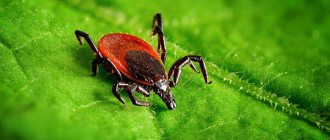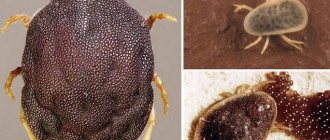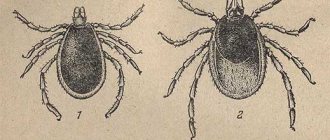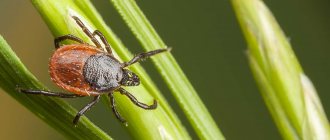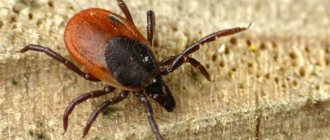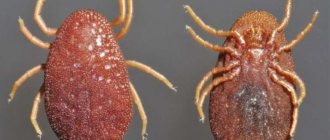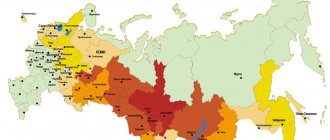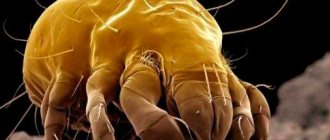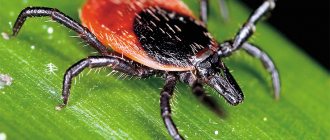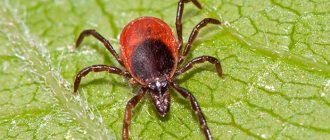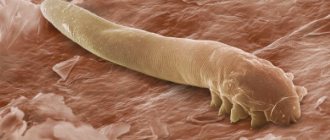The peak activity of ticks in Russia occurs in May-June. During these same months, the peak incidence of tick-borne infections is usually recorded. As Rospotrebnadzor reported on June 16, the number of calls to medical organizations for victims of tick bites this year does not exceed the long-term average.
According to the federal service, in 2022, 16,250 Russians turned to doctors with complaints of tick bites. In total, over the past year, 329 cases of tick-borne infections were identified in the country.
In nature, there are over 50 thousand species of these arthropod arachnids, but most of them do not pose a threat to humans. Only three types of ticks are dangerous to people and animals: ixodid, argasso and gamas, because they are attracted by the heat of a living organism.
What new type of dangerous ticks has appeared in Russia? More details
The most numerous of these species are ixodid ticks. On the territory of our country you can find such representatives as Ixodes, Haemaphysalis, Dermacentor, Hyalomma, Rhipicephalus. They are carriers of the tick-borne encephalitis virus, tularemia and other dangerous diseases.
Taiga tick (lat. Ixodes persulcatus)
The taiga tick is considered one of the main carriers of tick-borne encephalitis and Borrelia, the causative agents of Lyme borreliosis. It lives in the Moscow, Leningrad, Ulyanovsk and Samara regions, within the middle and southern subzones of the taiga, in the southern regions of Karelia and Kamchatka, on Sakhalin, the Far East and in other regions of the country.
Typically, taiga ticks do not climb to a height of more than one meter. They can be found in the grass along forest paths and roads, especially in the taiga, mixed forests, spruce forests and in the forest-steppe zone. However, these ticks can also lie in wait in green areas of cities, in summer cottages, in parks and squares, in cemeteries and other places.
What should I do if bitten by a tick?
If it turns out that the tick has already bitten, you need to urgently remove it from the surface of the skin. This can be done with your own hands or at a medical center. The second option is safer, plus the emergency room workers will immediately send the parasite for examination to a laboratory, if available.
The sooner a person notices and removes a tick, the less likely it is that it will become infected.
If it is not possible to contact a specialist, you can remove the tick yourself at home. It is worth remembering: when removing a tick from the skin, it is important not to crush it, so that the insides do not fall into the open wound. Grab the tick's body with tweezers close to the surface of the skin, next to the head, and gently twist it counterclockwise. If you don’t have tweezers at hand, you can use ordinary thread - make a loop out of it and tie it around the parasite, then smoothly pull it out.
There is also a folk remedy - drop oil on the tick. We don't recommend doing this. Firstly, the likelihood that the tick will come out on its own after this procedure is extremely low; rather, it will try to burrow even deeper under the skin. And secondly, this method can kill the parasite, and it is important for us to deliver it to the laboratory alive.
After the bloodsucker is removed, the bite site should be treated with an alcohol solution. The parasite and its parts should be placed in a small jar or other container with a couple of drops of water on a piece of cotton wool. This will save it. After which you need to deliver the tick for examination, the results of which will be known in about two days. The analysis will reveal whether it is a simple tick or one infected with encephalitis.
If you have been vaccinated against tick-borne encephalitis, then if you are bitten, you should simply remove it. No additional research is required.
Infection with encephalitis is similar to the onset of the influenza virus. It is characterized by muscle weakness, fever, increased temperature, chills, nausea with vomiting and pain when moving in the limbs. There is also a headache, especially in the temples and frontal part, thirst, dry mouth and all this is accompanied by pain in the eye sockets.
Forest tick (lat. Ixodes ricinus)
The forest tick (also known as the dog tick, the European forest tick and the cattle tick) is especially likely to carry tick-borne encephalitis and borrelia, which are dangerous to humans. In addition, its bite can cause diseases such as Q fever (accompanied by general toxic phenomena, fever and often atypical pneumonia), babesiosis (characterized by severe fever, enlarged liver and spleen), tularemia, relapsing tick-borne fever and granulocytic anaplasmosis (accompanied by high fever and general intoxication) and other infections of animals and humans.
Like other arthropods, this tick usually lives in the forest, but can also be found in meadows and bushes. The forest tick is especially common in the European part of Russia.
Can ticks and mosquitoes spread coronavirus? More details
Habitats
Ticks belong to the class of arachnids, are small in size (from 2 to 5 mm) and live almost all over the world. There are about 700 species in total.
Most ticks prefer to settle in deciduous forests, in lowlands with high humidity, and in wetlands. The main condition is tall and thick grass. They can live on low trees and bushes. For the most part, ticks feed on the blood of warm-blooded animals.
Some species coexist with humans. For example, saprophytes, that is, dust mites. They feed on dead skin particles. There are also mites that live directly on the body - demodexes. They live in the upper layer of the epidermis and near the hair follicles. Subcutaneous mites are so small that they are impossible to see with the naked eye.
Pasture mite (lat. Dermacentor marginatus)
An encounter with a pasture tick can result in infection with tick-borne encephalitis, Omsk hemorrhagic fever, tularemia, listeriosis, Q fever and other diseases. Typically this species parasitizes cattle, but adult individuals often “attack” people.
The pasture tick lives in the south of the European part of Russia, Western Siberia, Crimea, the Caucasus (including Transcaucasia), and the Middle and Lower Volga regions. It is usually found in mountain-steppe regions, but can also live in forest-steppe and mountain-forest areas.
When ticks are active
The peak of tick activity is considered to be from April to the end of June; ticks pose the greatest danger to urban areas in May. Warm weather stimulates the activity of insects, causing the number of attacks and bites on people and pets to increase significantly. The second peak of activity occurs at the end of summer (from August to mid-October), but single groups of insects can be active during other periods. Cases of tick bites have been recorded in March, November and even in winter.
Pavlovsky's mite (lat. Ixodes pavlovskyi)
Pavlovsky's mite was first identified in Russia in the mid-twentieth century in the Far East. However, subsequently it began to be detected in Western Siberia, and isolated cases were also recorded in Eastern Siberia.
Question answer
Will the number of ticks increase in the summer of 2022? Today, this tick is represented in the country by two subspecies: I. pavlovskyi pavlovskyi Pomerantsev, which lives in the Far East, as well as the Siberian I. pavlovskyi occidentalis Filippova and Panova. The latter is widespread in the lowland areas of the Novosibirsk and Tomsk regions. Experts note that in some areas the Pavlovsky tick has almost completely replaced the taiga tick, with which it has much in common. The Pavlovsky tick is also a carrier of the same infectious agents - encephalitis and borrelia.
How dangerous is a bloodsucker?
There are more than 50 thousand species of ticks on earth. Of these, 713 are ixodid species. Of these, about 70 species are found in Russia. They are all vampires, or "temporary highly specialized obligate hematophages." All of them can be carriers of viruses, rickettsia, bacteria, spirochetes, trypanosomes, filariae and piroplasmids, which can cause more than 300 infectious and parasitic diseases in the donor. In addition, as a result of the suction of forest and taiga ixodid ticks, mixed infections often develop, which are characterized by a more severe course of the disease.
The most common disease transmitted through tick bites is borreliosis, or Lyme disease. In half of the cases, the bite site turns red, the spot expands, reaching a significant size in diameter. In some cases, borreliosis is initially asymptomatic or disguised as other diseases, for which it is called invisible. In later stages, the disease leads to damage to the joints, heart and nervous system. Borreliosis does not apply to pets.
The most dangerous tick-borne infections for humans are encephalitis (incidence in Russia has increased by 16 percent over the past year) and Crimean hemorrhagic fever (139 cases per year).
Well, our best friends - dogs, if they are small, old or weakened - easily die from babesiosis (pyroplasmosis), which destroys red blood cells. Unfortunately, there are no statistics on dogs dying from ticks.
All tick-borne infections can be treated in the early stages, but the only way to avoid catching borreliosis is to prevent tick bites.
Hybrid of the Taiga tick (lat. Ixodes persulcatus) and Pavlovsky tick (lat. Ixodes pavlovskyi)
Information about the hybrid first appeared in 2009. It was confirmed in June 2022, after Russian scientists sequenced (i.e. deciphered) the arthropod genome. According to the journal of the Siberian Branch of the Russian Academy of Sciences “Science in Siberia”, the new species could have formed due to the fact that both types of ticks live in the same territory.
The danger of a hybrid lies in the fact that it is a carrier of all diseases carried by the parent species. This is a tick-borne encephalitis virus, various types of Borrelia, Rickettsia (intracellular parasites that cause acute febrile diseases, including epidemic typhus), Ehrlichia (affect the skin, liver, central nervous system and bone marrow, forming infectious granulomas in these organs), Anoplasma (pathogen blood disease granulocytic anaplasmosis, which is accompanied by high fever and general symptoms of intoxication), as well as Babesia (intracellular parasites that attack red blood cells), which especially often infect dogs.
You can encounter these ticks in May-June in the Novosibirsk region in deciduous and mixed forests, valleys of forest rivers and streams.
In which regions do tick-borne encephalitis occur most often? More details
Encephalitis ticks in Russia - a Japanese biological bomb?
Encephalitis ticks in Russia - a Japanese biological bomb?
Photo: GLOBAL LOOK PRESS
Russia is considered the world leader in tick-borne encephalitis. 2–3 thousand patients per year! Every spring, more than 3.5 billion arthropod midgets creep out to hunt in our forests, fields, meadows, city parks... Only at the end of cold April 2022, according to Rospotrebnadzor, 12,661 bitten Russians turned to medical institutions. In May-June the number of victims will increase significantly. Holidays, vacations, school holidays, people are drawn to nature and fall into a tick ambush. Then the bloodsuckers will rest, and from the end of August they will begin to rampage again. Until the first frost. On average, half a million citizens visit doctors per season. And even though 6 out of every 100 ticks are infected with a dangerous virus, and only 2-6 percent of those bitten by them get sick, it’s still creepy. Encephalitis affects the brain. Two to three dozen victims die every year, many remain paralyzed for the rest of their lives. And there is also borreliosis (Lyme disease). There are no vaccinations for it, it is not as dangerous as encephalitis, but it will take a long time to be treated. There are other diseases that these little critters spread.
THE CHAMOMILES ARE HIDING...
Doctors are sounding the alarm. Recently, on the air of the Komsomolskaya Pravda radio, State Duma deputy, academician Gennady Onishchenko, former chief sanitary doctor of the Russian Federation, even urged men not to give buttercup daisies to their loved ones! “No wildflowers, no matter how much your knowledge of classical Russian and Soviet literature might push you to do so, which very often promoted collecting wildflowers and presenting them to your beloved women. And a more classic one is to place a bouquet of wildflowers next to your beloved’s bed in the morning. If there is a tick in the bouquet and your loved one gets sick, this will be regarded as a violation of basic safety rules. No forget-me-nots (as well as other flowers), unless you first treat them with some kind of disinfectant. Therefore, I demand that such manifestations of love for a woman be excluded!”
We made it! Now you don’t have to drive your bike for a long time, as in Barykin’s popular song, to pick flowers and give your beloved a bouquet. And you can’t run barefoot through the dew... And the expression “barefoot childhood” should also be put to rest.
But until recently we had never even heard of these vile bloodsuckers. At least in central Russia. In our Lipetsk village (400 km from Moscow), childhood was truly barefoot. From early spring to late autumn, kids walked around the meadows, gardens, and vegetable gardens in their underpants... As they grew up, they spent the night in haystacks with the beloved songbirds. And no arthropods were caught.
I personally learned about this scourge for the first time in the early 70s of the last century. At Leningrad University they hung an announcement: “Those traveling to study groups in the Far East and Siberia must be vaccinated against encephalitis.” It turns out that this disease is spread by some kind of ticks. But on this side of the Urals there was peace and grace.
After university I went to work in Tomsk. There I heard a lot of terrible stories about dead and paralyzed victims of ticks.
And in 1982 he got himself into trouble. In August we went to the taiga to visit a forester we knew to beat a pine cone. It’s hot, we climb the trees naked... In the evening we came to the shelter. With nuts. On the table there is steaming moonshine, boiled muksun, salted mushrooms... Paradise! I doused myself at the well to wash away the sweat and dirt. Lo and behold, there is a black spot left on my leg. I swipe it and it doesn’t lag behind. "Mite!" - the forester pronounced the verdict. He pulled out the infection and burned it. But he says he can’t drink. So the cold moonshine floated past.
I returned to Tomsk, my soul was restless. I called my friend, the head physician of the regional sanitary and epidemiological station, I previously did an interview with him about ticks: “Save me!” “Come, I’ll give you an imported vaccine, but don’t go to the hospital with it, there’s a shortage, questions will arise about where you got it. Look for a doctor at home." He came to his neighbor Lyudmila with the treasured ampoule. She once completed nursing courses. Not a word to my wife, so as not to scare her. I’m lying on Lyuda’s bed with my bare “soft spot” up, my savior is boiling a syringe in the kitchen (Soviet people remember, there were no disposable ones back then.) The doorbell rings. The wife comes in. And me with my pants down. Oil painting! I had to explain myself. It blew by. And with my wife, and with encephalitis. But I didn’t drink for three months, on the advice of the head physician. Just in case. And when he later happened to “go through it all,” his wife jokingly grumbled: “If only the tick bit you again...”.
In 1987 we moved from Tomsk to Moscow. Well, I think we can now calmly fish, walk through forests and meadows. Not so. Soon the Siberian-Far Eastern bloodsuckers occupied Central Russia. God has had mercy on me. And the son suffered twice. In the spring, while planting trees in honor of Victory Day, and in already cold October, during a camping trip with an overnight stay on a lake near Moscow. Now the ticks are being taken to the laboratory for testing. Not like in the USSR. The first one turned out to be clean, and the second one – with borreliosis. My son had to take antibiotics. But we hid the story from my wife so as not to worry.
This Easter I went to my native village. It’s mid-April, and a dozen bloodsuckers have been removed from Dick’s dog. Although he is wearing an expensive anti-mite collar. Gee.
Where did the arthropod invaders crawl into Mother Russia?
On the site of Unit 731 in Harbin there is now a memorial complex.
Photo: GLOBAL LOOK PRESS
THE PLEASURES OF THE MILITARY
There is a popular version that this is a biological time bomb of Japanese militarists, abandoned in the USSR back in the early 30s of the 20th century. I first heard it from a serious doctor of economic sciences. She also circulates widely on the Internet.
Here's a quick recap.
“Encephalitis was not known to the pioneers of Siberia and settlers to the Far East until the 1930s. In the 1920s, an epidemic occurred in Japan, killing several thousand people. The virus was transmitted by a mosquito. This may have been the first biological weapon test using insects. But the mosquito is too dangerous and an unpredictable spreader of a deadly disease. Therefore, the Japanese militarists chose a slower but surer method of transmitting the virus - a tick, widespread in the Far Eastern and Siberian taiga.
In 1937, an epidemic of an unknown disease began among soldiers of the Far Eastern group of the Red Army, often leading to death. A special expedition of military microbiologists, Professor Zilber, was urgently sent from Moscow. They discovered the virus and its carrier – the tick. Almost immediately they began to blame the Japanese military. But there was no evidence. Only after the Second World War did it become known about the existence on the territory of Manchuria of the notorious “Detachment 731” of the Kwantung Army, which had been conducting experiments with biological weapons since 1933. It was in that year, by the way, that our doctor Panov, for the first time in the USSR, made a clinical description of a new disease in the Far East. East. Later called tick-borne encephalitis. In 1945, after the USSR entered the war with Japan, by order of the commander of the Kwantung Army, General Otazo Yamada, the secret military camp of microbiologists was destroyed. However, it was not possible to hide all traces of the crime: the testimony collected in this case was included in the materials of the Khabarovsk trial of Japanese war criminals in 1949. In Japan, the epidemic of mosquito encephalitis was suppressed and completely eliminated. In the USSR and Russia, tick-borne encephalitis turned out to be a ticking time bomb. In the 1960s, an infected tick crossed the Yenisei, in the 1980s it crawled across the Urals and is currently found throughout Russia.”
"CHEAP AND POWERFUL"
Well, that sounds very convincing. And according to the dates, everything works out logically.
For a comment, I turned to Mikhail SUPOTNITSKY, Candidate of Biological Sciences, Colonel of the Reserve Medical Service. For more than thirty years, he has been studying the mechanisms of the emergence and spread of pathogens of the most dangerous infectious diseases among people, and the fight against them. Author of the monumental scientific work “Biological Warfare”. By the way, several years ago, at the height of universal fears about swine flu and Ebola fever, which allegedly threatened to wipe out half the world, Supotnitsky debunked these horror stories from the pages of Komsomolskaya Pravda. Regarding the same Ebola, he declared, in defiance of Obama and other politicians and scoundrel scientific luminaries, that it would not spread beyond Africa and would soon subside on its own. And so it happened. No one remembers Ebola or swine flu. But what passions were in full swing!
-Mikhail Vasilyevich, what can you say about the notorious “Detachment 731”? Was he really there?
- Unfortunately yes. Biological weapons, as they were then considered, “cheap but powerful,” were taken seriously in Japan in August 1932. In the first half of the 1930s. the Japanese created secret laboratories and scientific centers in Japan itself; in Harbin, the capital of the puppet state of Manchukuo (“Kamo Detachment”); in Japanese-occupied central China (Nanjing, "A Troop") and possibly in parts of Southeast Asia.
In June 1936, by secret decree of Emperor Hirohito, not far from Harbin, a Chinese city with Russian roots, captured by the Japanese, construction began on a large military-bacteriological complex, which went down in the history of World War II as “Detachment 731.” The detachment reported directly to the commander of the Kwantung Army. The object had the shape of a square with a side of 6 km. Surrounded by a moat and a fence with barbed wire through which a high voltage current was passed. Plus four branches along the Soviet-Manchurian border, testing grounds for promising new weapons. The detachment employed more than 2,600 people in scientific research work on the preparation and conduct of biological warfare and sabotage. Three lieutenant generals of the medical service, five or six major generals, sixteen colonels, more than twenty lieutenant colonels and majors, and almost three hundred junior officers and officer candidates. There were many civilians. Doctors of medicine who worked in the field of bacteriology were gathered here from almost all of Japan, and among them there were more than ten people equated to generals, and over thirty to colonels.
- Wow scope!
— The Japanese army also had “Detachment 100,” subordinate to the veterinary service, designed to kill farm animals. There were similar units involved in the development and testing of chemical weapons. The full picture of the Japanese attempts to develop and use biological weapons in World War II, especially the blunt atrocities committed to test their destructive properties on captured Russians and Chinese, can hardly be reconstructed. The leaders of the Japanese military biological program, Generals Ishiya Shiro and Kitano Masazo, defected to the Americans after the war and their new masters were not interested in revealing the whole truth about the crimes they committed. Since 1942 alone, at least three thousand prisoners of Unit 731 have died in laboratories and during testing of biological weapons at testing grounds.
The Japanese militarists placed the main emphasis on the plague, the most terrible disease, as they believed, in epidemic terms. They dealt with typhoid fever, paratyphoid fever, dysentery, cholera, anthrax, glanders, gas gangrene, tetanus, cattle plague, sheep pox and other infectious diseases that could massively destroy people and animals during biological warfare or sabotage.
They worked in teams and with insects. First of all, with fleas, carriers of the plague. There is a lot of documentary evidence of these criminal plans in my book “Biological Warfare” and in Seiichi Morimura’s book “The Devil’s Kitchen” (1983). However, all the efforts of Japanese microbiologists were in vain; they were unable to create biological weapons suitable for use due to a huge number of problems that were insoluble at that level of development of biological science and military technology.
Mikhail Vasilievich SUPOTNITSKY. Photo: Personal archive
EXPERIMENTS ON HUMANS
— Is tick-borne encephalitis also the work of the Japanese military?
— In “Detachment 731” they actually worked with the tick-borne encephalitis virus. The leader of this work was Kitano Masadzo. The experiments were carried out on people, but in the article they published in the Journal of the Japanese Scientific Society of Pathological Physiology (1944, No. 43), they indicated monkeys instead of people. At that time, there were no technologies to obtain tick-borne encephalitis virus in large quantities. For infection, they usually used an emulsion of the brains of recovered mice. Ticks have a very complex reproduction cycle; it is very difficult to predict the fate of the virus in generations of ticks. After the war, the US military had extensive programs to use ticks, mosquitoes and other insects to spread infectious disease agents, but they all failed. In 1952, during the war on the Korean Peninsula, American aircraft used this method of conducting biological warfare, the result did not live up to expectations. In the 1960s, with funding immeasurably greater than the Japanese had during World War II, the American military lost interest in using insect vectors for biological warfare.
QUESTION - RIB
SO WHO LAUNCHED THE VIRUS?
— If the stories about the Japanese biological bomb are a myth, where did tick-borne encephalitis come from? After all, it was discovered only 80 years ago in the Far East.
“It has always been there; a person is not needed to maintain it in nature.” Virology is a young science, it is just over 100 years old. Therefore, all dangerous viruses were discovered in the twentieth century, and continue to be discovered in the current century. This does not mean that they appeared recently, they are millions and billions of years old. Viruses live in a different time dimension than we do, since they are actually immortal. In the 1930s Active development of the Far East began, and then “the sleeper woke up.” And glory to our wonderful scientists A. Panov, L. Zilber, A. Smorodintsev and others, who managed to recognize the causes of another encephalitis occurring in Russia.
— Why have ticks now reached the central part of Russia, where they have never been? They have become almost a national disaster.
— Ticks have always been in Central Russia, although not in such numbers, and not so infected with the tick-borne encephalitis virus. It is necessary to look for the reasons for their reproduction and infection in changing environmental conditions, climate warming, which have caused global shifts in ecosystems that accommodate both the ticks themselves and the microorganisms parasitizing them. Ticks infected with the encephalitis virus could not crawl from the Far East; the source of their infection is in Central Russia, in some natural reservoirs unknown to scientists. Ticks gradually penetrate these reservoirs and become infected. The myth about Unit 731’s involvement in the emergence of ticks infected with the tick-borne encephalitis virus is, of course, beautiful, but it takes scientists away from studying the real causes of this process.
— What can we expect next in Russia from this scourge? Do you somehow protect yourself from ticks, do you get vaccinations? Professional advice.
-This “scourge” will live in parallel with us; you cannot push it aside with your hand. Therefore, tick-borne encephalitis and the ecology of its causative agent must be carefully studied. I myself protect myself from infection by trying to avoid places where it is possible to meet encephalitis ticks. I do not vaccinate. Well, Rospotrebnazdor gives professional advice. Please follow these tips very carefully.
FROM THE KP DOSSIER
Mikhail Vasilyevich SUPOTNITSKY , 60 years old. Graduated from the Military Medical Faculty at the Tomsk Medical Institute. Microbiologist, candidate of biological sciences, senior researcher. From 1979 to 2006, he worked in various positions in research institutions of the Ministry of Defense of the USSR and the Russian Federation. Colonel of the reserve medical service. Author of the books “Microorganisms, toxins and epidemics” (2000, 2005, 2010), “Essays on the history of the plague” (2006), “Dictionary of genetic terms” (2006), “Evolutionary pathology” (2009), “Biological warfare. Introduction to the epidemiology of artificial epidemic processes and biological lesions" (2013), "Blind spots of vaccinology" (2016). Author of 5 inventions on means of specific prevention of anthrax, glanders and melioidosis.
LOOK OUT!
ROSPOTREBNADZOR OF THE RF WARNING!
— Wear clothing that fits tightly to your body when visiting forests and green areas.
— Do not rest in shaded areas with tall grass. You cannot sit or lie down on the grass; ticks cling to clothing from the grass and always crawl up.
— When choosing a parking place or spending the night in nature, you need to choose dry places with sandy soil or areas devoid of grass.
— Use tick repellents, which can be purchased at any pharmacy or supermarket.
— Every 10-15 minutes, conduct self- and mutual examinations for the presence of ticks. Inspect the clothing, paying attention to the seams, collar, where ticks may be hiding.
— Regularly inspect your pets after walks in nature, in the local area.
— If you are bitten by a tick, seek medical help at a clinic or emergency room.
At what temperature do ticks live?
The existence of ticks, like any other insects, is subject to a special rhythm set by nature.
- If the snow has already melted, the sun has begun to warm the earth, and daytime temperatures remain above +10 degrees for several days in a row, ticks come out of hibernation.
- The most favorable weather for ticks is from 18 to 20 degrees Celsius, with a relative humidity of 80% and above.
- The more temperature and humidity indicators deviate in one direction or another, the less active mites are.
- When the daily temperature becomes stably below +10 degrees, ticks begin to look for shelter for the winter and gradually fall into suspended animation until next spring.
This life cycle also explains the presence of bursts of parasite activity, which lead to talk of a tick invasion. In Moscow and the Moscow region, peak periods of tick activity occur mainly in May-June and August-September, since it is at this time that conditions for insects are as close to ideal as possible.
All places where ticks live are located within 1.5–2 meters from the ground. In garden plots, pests can hide in:
- Firewood stacked on the street
- Garbage
- Dry wood
- Cut or broken branches
- Greenhouses
- Topsoil and decaying plant litter
However, most often ticks live in grass. The higher and thicker it is, the more comfortable it is for the parasite.
Meet the Ixodid tick
Many ixodid ticks have only light-sensitive cells instead of eyes, so they use other senses to “hunt.”
At long distances the main role is played by the multifunctional Haller organ
, with the help of which ticks are able to perceive changes in the concentration of carbon dioxide, specific components of the smell of a potential host (hydrogen sulfide, ammonia) and its thermal radiation at a distance of up to 10 m. Having reached the “victim”, ticks determine the most suitable place for suction using sensitive sensilla, consisting of cuticular hair and receptor cells, which are especially numerous on the paws and mouthparts.
Ticks are often mistakenly called insects, but it is easy to distinguish a potential bloodsucker from a harmless bug: adult ticks have eight legs, like spiders, and not six, like insects. Together with spiders, mites form the class of arachnids (Arachnida), which, along with crustaceans, insects and centipedes, is included in the phylum of arthropods (Arthropoda). Today, more than 50 thousand different types of ticks are known, many of which are parasites, although not all of them pose a danger to humans or domestic animals. The ixodid tick family Ixodidae includes six main genera: Ixodes
(249 species),
Haemaphysalis
(166),
Amblyomma
(142),
Rhipicephalus
(79),
Dermacentor
(36),
Hyalomma
(25 species).
The Latin name of each tick consists of two parts: an indication of the genus and species, and well-studied species also have a Russian name. For example, taiga tick
(
Ixodes persulcatus
),
meadow tick
(
Dermacentor reticulatus
).
Ixodid ticks are the largest of all ticks: adults reach 2–13 mm in length. The most common taiga tick in Russia, I. persulcatus,
has a body length of 3–4 mm for a hungry female, 2–3 mm for a male, 1.2–1.7 mm for a nymph, and less than 1 mm for a larva. The size of engorged ticks is significantly larger
The paired salivary glands of the tick secrete a secret containing many biologically active components that act as an analgesic, prevent blood clotting, suppress the host's immune responses, stimulate the release of histamine by the host's cells, etc. They can also secrete components of the cement sheath involved in fixing the tick on the body owner.
Another unique function of the salivary glands is osmoregulation. When there is a threat of drying out, hygroscopic saliva is secreted into the pre-oral cavity of the tick, which adsorbs water molecules from the air, which allows the tick to retain the necessary moisture in the body and remain viable for many months between blood meals. And, on the contrary, when feeding on blood, the tick is able to return about 70% of the “excess” absorbed water and salts by salivating at the bite site. As a result, the volume of saliva secreted by the tick during the entire feeding period significantly exceeds the body weight of the engorged tick (Biology of Ticks, 2014).
The body of the ixodid tick consists of two sections: an unsegmented body, bearing legs (6 in larvae, 8 in nymphs and adult males and females), and a head. On the dorsal side there is a hard shield, which in females, nymphs and larvae covers only the anterior third or half of the body. The rest is covered with an extensible cuticle, which in hungry individuals forms a system of parallel microfolds that straighten during feeding.
Most ixodid ticks are characterized by the grazing-lurking type.
parasitism: hungry individuals climb onto vegetation, where they lie in wait for potential hosts passing by. Having received the necessary signals, the tick goes into a state of “active lurking,” making oscillatory movements with the first pair of legs extended forward until direct contact with the host animal.
For many ticks of the genus Ixodes
The nest-burrow type
is characteristic , when hungry individuals at all stages of development attack potential hosts in burrows and nests;
some have a mixed type of parasitism. There are also ticks adapted to living in houses, for example, the dog tick Rhipicephalus sanguineus
(Balashov, 1998; Yakimenko, 2013; Biology of Ticks, 2014).
Where can you find ticks
Where can you find ticks
The largest number of ticks is found in forested areas; they can be found while walking, searching for mushrooms and berries, or resting near trees.
Park areas, squares and gardens will also be an excellent habitat for ticks. They can be located on tall grass, small bushes, on the ground and trimmed lawn.
The home yard can also be an excellent habitat for ticks; it is recommended to periodically spray the area with special insecticides, as well as check for the presence of parasites with a fabric trap. In the morning, you can stretch a light waffle towel across the grass - if there are ticks, at least 1 will cling to the fabric, so you will know for sure that the measures will not be taken in vain.
Ticks often end up in living spaces carried there by pets. Tangled in the thick fur of a dog or cat, ticks are invisible to the naked eye, so you should always carefully examine your pet’s body after walks.
How to remove a tick
If the provided protection against ixodid ticks was not effective, and the insect bit you, the first thing you should do is remove the body of the parasite from your skin. The sooner you do this, the fewer viral cells you will receive from the tick.
People's advice is to lubricate the bite with oil, but it will take a very long time to wait for the results. In addition, the oil does not kill the insect, it only blocks its spiracle and prevents air from entering.
The easiest way to get the parasite is with a thread - you need to tie a thread around the protruding part of the insect and twist it (clockwise or counterclockwise). For this purpose, it is also convenient to use tweezers or special medical devices, but in the wild, thread is the best option.
How to protect yourself from ticks
How to protect yourself from ticks
There are a lot of means to combat ticks; it is much easier to prevent bites than to treat their consequences. Preventive measures are:
- vaccination – recommended in case of travel to dangerous regions for adults and children over 3 years old. However, it should be noted that a vaccine against borreliosis and some other diseases transmitted by ticks has not yet been found, so such prevention is not considered a 100% guarantee of safety;
- the right equipment - when going to the forest or steppe, the optimal clothing will be pastel light fabrics, on which insects can be easily seen. The legs of the trousers should be tucked into the shoes, the body should be covered with clothing as much as possible;
- modern drugs – recently, innovative effective drugs against ticks and other insects have appeared. These can be creams, gels and repellent sprays. But for high-quality effective protection, they should be periodically updated - the effect of the spray is limited to 2-3 hours, the cream and gel must be reapplied after 4-5 hours, otherwise the compositions will not provide the desired effect.
Both the table and the house
Having clung to the host, ticks actively search for a suitable place to attach, preferably where it is more difficult for the host to get rid of them, for example, on the ears and head of rodents.
On hedgehogs with their spines, mites are more evenly distributed, but on primates there are practically no mites. In regions with a dry and hot climate, ticks more often stick to the lower part of the body, protected from the sun. They can even be found in the mouths of elephants and in the nostrils of hippos and camels. Ticks attach themselves to people in a variety of places: in the armpits, less often on the chest, abdomen, arms, buttocks and legs, as well as on the head, especially in children.
Ticks attach to the host's skin with their mouth parts, cut through it and use their proboscis to suck out blood, inflammatory infiltrate and tissue dissolution products, alternating this process with the introduction of saliva into the wound.
Ixodid ticks feed slowly: larvae feed for 3–5 days, females for 5–15 days. During feeding, their body weight increases by one or two orders of magnitude: females of the largest species can absorb up to 8–10 ml of blood!
After finishing feeding, the larvae and nymphs fall away from the host and molt, moving to the next stage of development. In adult ticks, feeding is associated with reproduction. Partners, as a rule, meet on their host - hungry male and female ticks are not able to mate, with the exception of ticks of the genus Ixodes
. The male can remain on the host for several months and during this time fertilize several dozen females. The female mates only once, after which she quickly gains weight, falls away from the owner and after some time (from several days to months) lays eggs (from 800 to 20,000 depending on the species), after which she dies (Balashov, 1998; Biology of Ticks, 2014).
In most cases, the development of ixodid ticks occurs with a change of host at each stage of the life cycle. Their feeders are birds, reptiles and, first of all, mammals, especially rodents. Thus, the taiga tick parasitizes approximately 170 species of birds, 100 species of mammals and several species of reptiles. As a rule, small animals moving in the lower tiers are attacked by larvae and nymphs, and large animals are attacked by adult ticks (Balashov, 1998; Biology of Ticks, 2014).
